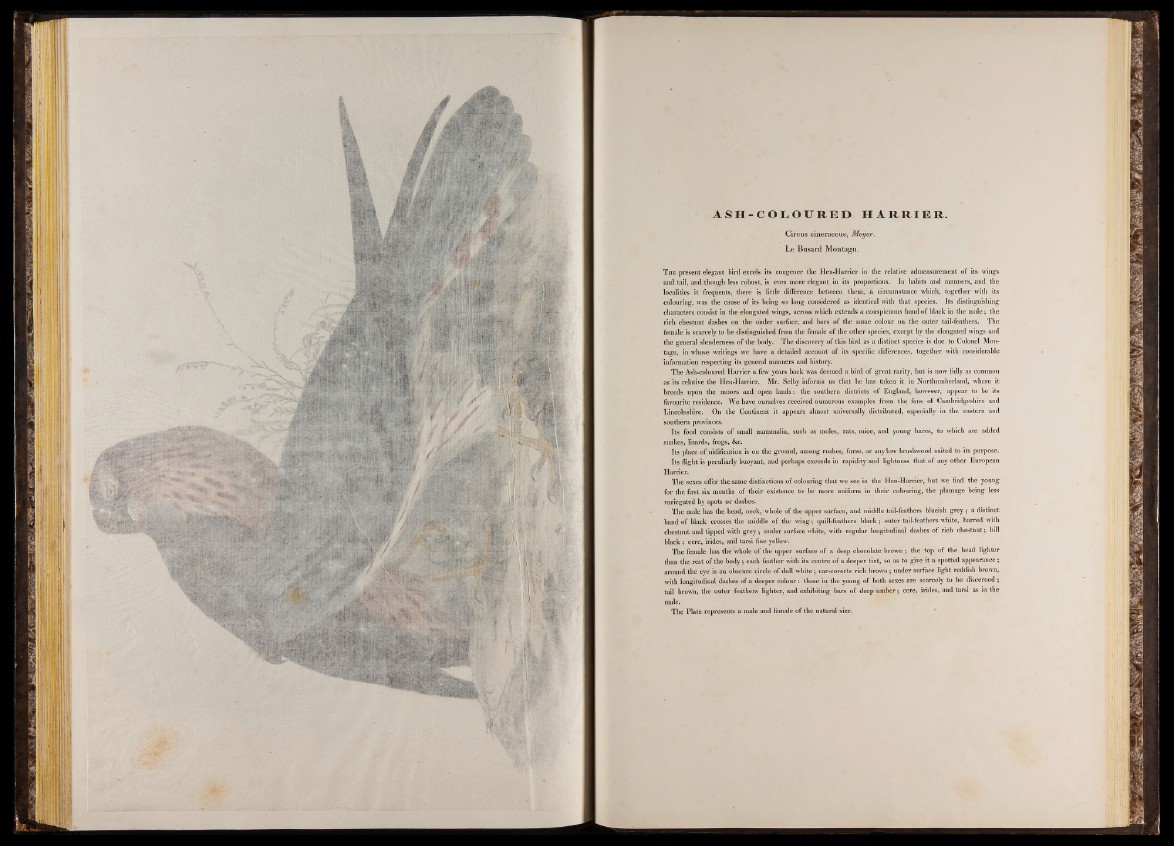
A SH -CO LO U R E D HA R RIER .
Circus cineraceus, Meyer.
Le Busard Montagu.
T he present elegant bird excels its congener the Hen-Harrier in the relative admeasurement of its wings
and tail, and though less robust, is even more elegant in its proportions. In habits and manners, and the
localities it frequents, there is little difference between them, a circumstance which, together with its
colouring, was the cause of its being so long considered as identical with that species. Its distinguishing
characters consist in the .elongated wings, across which extends a conspicuous band of black in the male; the
rich chestnut dashes on the under surface, and bars of the same colour on the outer tail-feathers. The
female is scarcely to be distinguished from the female of the other species, except by the elongated wings and
the general slenderness of the body. The discovery of this bird as a distinct species is due to Colonel Montagu,
in whose writings we have a detailed account of its specific differences, together with considerable
information respecting its general manners and history.
The Ash-coloured Harrier a few years back was deemed a bird of great rarity, but is now fully as common
as its relative the Hen-Harrier. Mr. Selby informs us that he has taken it in Northumberland, where it
breeds upon the moors and open lands: the southern districts of England, however, appear to be its
favourite residence. We have ourselves received numerous examples from the fens of Cambridgeshire and
Lincolnshire. On the Continent it appears almost universally distributed, especially in the eastern and
southern provinces.
Its food consists of small mammalia, such as moles, rats, mice, and young hares, to which are added
snakes, lizards, frogs, Sic.
Its place of nidification is on the ground, among rushes, furze, or any low brushwood suited to its purpose.
Its flight is peculiarly buoyant, and perhaps exceeds in rapidity and lightness that of any other European
Harrier.
The sexes offer the same distinctions of colouring that we see in the Hen-Harrier, but we find the young
for the first six months of their existence to be more uniform in their colouring, the plumage being less
variegated by spots or dashes.
The male has the head, neck, whole of the upper surface, and middle tail-feathers blueish grey; a distinct
band of black crosses the middle of the wing; quill-feathers black; outer tail-feathers white, barred with
chestnut and tipped with grey ; under surface white, with regular longitudinal dashes of rich chestnut; bill
black; cere, irides, and tarsi fine yellow.
The female has the whole of the upper surface of a deep chocolate brown ; the top of the head lighter
than the rest of the body; each feather with its centre of a deeper tint, so as to give it a spotted appearance;
around the eye is an obscure circle of dull white; ear-coverts rich brown; under surface light reddish brown,
with longitudinal dashes of a deeper colour: these in the young of both sexes are scarcely to be discerned ;
tail brown, the outer feathers lighter, and exhibiting bars of deep umber; cere, irides, and tarsi as in the
male.
The Plate represents a male and female of the natural size.